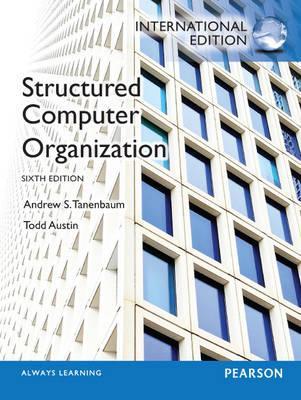

Most ebook files are in PDF format, so you can easily read them using various software such as Foxit Reader or directly on the Google Chrome browser.
Some ebook files are released by publishers in other formats such as .awz, .mobi, .epub, .fb2, etc. You may need to install specific software to read these formats on mobile/PC, such as Calibre.
Please read the tutorial at this link: https://ebookbell.com/faq
We offer FREE conversion to the popular formats you request; however, this may take some time. Therefore, right after payment, please email us, and we will try to provide the service as quickly as possible.
For some exceptional file formats or broken links (if any), please refrain from opening any disputes. Instead, email us first, and we will try to assist within a maximum of 6 hours.
EbookBell Team

4.7
66 reviews
ISBN 10: 0132916525
ISBN 13: 9780132916523
Author: Andrew Tanenbaum, Todd Austin
This is the eBook of the printed book and may not include any media, website access codes, or print supplements that may come packaged with the bound book. Structured Computer Organization, specifically written for undergraduate students, is a best-selling guide that provides an accessible introduction to computer hardware and architecture. This text will also serve as a useful resource for all computer professionals and engineers who need an overview or introduction to computer architecture. This book takes a modern structured, layered approach to understanding computer systems. It's highly accessible - and it's been thoroughly updated to reflect today's most critical new technologies and the latest developments in computer organization and architecture. Tanenbaum’s renowned writing style and painstaking research make this one of the most accessible and accurate books available, maintaining the author’s popular method of presenting a computer as a series of layers, each one built upon the ones below it, and understandable as a separate entity.
Chapter 1: Introduction
1.1 Structured Computer Organization
1.1.1 Languages, Levels, and Virtual Machines
1.1.2 Contemporary Multilevel Machines
1.1.3 Evolution of Multilevel Machines
1.2 Milestones in Computer Architecture
1.2.1 The Zeroth Generation – Mechanical Computers
1.2.2 The First Generation – Vacuum Tubes
1.2.3 The Second Generation – Transistors
1.2.4 The Third Generation – Integrated Circuits
1.2.5 The Fourth Generation – Very Large Scale Integration
1.2.6 The Fifth Generation – Low-Power and Invisible Computers
1.3 The Computer Zoo
1.3.1 Technological and Economic Forces
1.3.2 The Computer Spectrum
1.3.3 Disposable Computers
1.3.4 Microcontrollers
1.3.5 Mobile and Game Computers
1.3.6 Personal Computers
1.3.7 Servers
1.3.8 Mainframes
1.4 Example Computer Families
1.4.1 Introduction to the x86 Architecture
1.4.2 Introduction to the ARM Architecture
1.4.3 Introduction to the AVR Architecture
1.5 Metric Units
1.6 Outline of This Book
Chapter 2: Processors, Memory, and I/O
2.1 Processors
2.1.1 CPU Organization
2.1.2 Instruction Execution
2.1.3 RISC versus CISC
2.1.4 Design Principles for Modern Computers
2.1.5 Instruction-Level Parallelism
2.1.6 Processor-Level Parallelism
2.2 Primary Memory
2.2.1 Bits
2.2.2 Memory Addresses
2.2.3 Byte Ordering
2.2.4 Error-Correcting Codes
2.2.5 Cache Memory
2.2.6 Memory Packaging and Types
2.3 Secondary Memory
2.3.1 Memory Hierarchies
2.3.2 Magnetic Disks
2.3.3 IDE Disks
2.3.4 SCSI Disks
2.3.5 RAID
2.3.6 Solid-State Disks
2.3.7 CD-ROMs
2.3.8 CD-Recordables
2.3.9 CD-Rewritables
2.3.10 DVD
2.3.11 Blu-ray
2.4 Input/Output
2.4.1 Buses
2.4.2 Terminals
2.4.3 Mice
2.4.4 Game Controllers
2.4.5 Printers
2.4.6 Telecommunications Equipment
2.4.7 Digital Cameras
2.4.8 Character Codes
Chapter 3: Gates and Boolean Algebra
3.1 Gates and Boolean Algebra
3.1.1 Gates
3.1.2 Boolean Algebra
3.1.3 Implementation of Boolean Functions
3.1.4 Circuit Equivalence
3.2 Basic Digital Logic Circuits
3.2.1 Integrated Circuits
3.2.2 Combinational Circuit
structured computer organization 6th pdf
structured computer organization 6e tanenbaum
structured computer organisation tanenbaum
structured computer organization solutions
structured computer organization sixth edition
structured computer organization reddit
Tags: Andrew Tanenbaum, Todd Austin, computer, organization